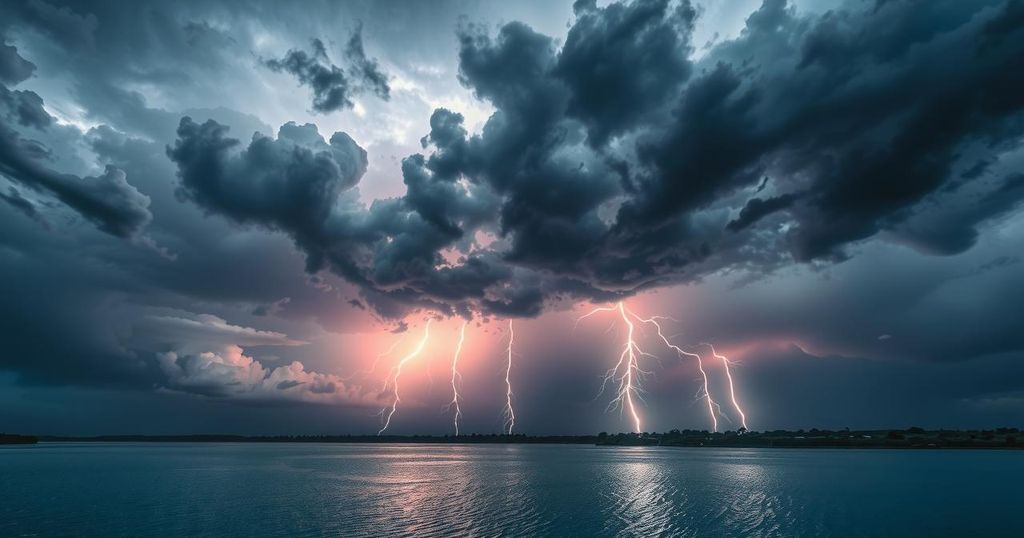Weather
World news
AFRICA, AVE, AVELINO MUCHINE, CHINDE, DA COSTA, DISASTER MANAGEMENT, FLOODING, FLOODS, HELD, ING, LANDSLIDE, MOCUBA, MONSOON, MORRUMBALA, MOZAMBIQUE, NATIONAL INSTITUTE FOR NATURAL DISASTER RISK MANAGEMENT AND REDUCTION, NATURAL DISASTERS, NICOADALA, NOT, REPRESENTATION COUNCIL, ZAMBÉZIA
Lena Nguyen
0 Comments
Tragic Impact of Lightning Strikes in Zambézia, Mozambique: 17 Confirmed Deaths
In Zambézia, Mozambique, lightning strikes have resulted in 17 fatalities and injuries to 46 individuals since October. The rainy season has caused significant infrastructure damage, destroying homes, health units, and schools. Local authorities have begun humanitarian assistance, aiding affected families with essential supplies and prepositioning vessels for resource distribution. The government is urged to strengthen communication and partnerships to address these challenges.
In Mozambique’s Zambézia province, severe lightning strikes have resulted in the tragic deaths of at least seventeen individuals, with an additional forty-six people suffering injuries since October of the previous year. Local authorities report that 120 families have received assistance due to extensive rains and flooding experienced during this period. The statistics were shared by Hélder da Costa, provincial delegate of the National Institute for Natural Disaster Risk Management and Reduction, during the recent State Representation Council meeting in Quelimane.
Since the rainy season commenced, Zambézia province has experienced moderate to heavy rainfall, with amounts reaching 30 millimeters within a 24-hour period, particularly affecting districts such as Morrumbala, Alto Molócuè, Maganja da Costa, Chinde, Milange, Mocuba, and Quelimane. Consequently, over 800 homes have been entirely destroyed, while 1,300 additional structures, including nine health units and 46 schools, have sustained partial damage, disrupting educational activities for 22,000 students and impacting 390 teachers.
The provincial infrastructure has also faced significant challenges, with 63.94 kilometers of roads damaged and the collapse of 44 electricity transmission poles. Furthermore, approximately 36 hectares of agricultural land have been flooded, exacerbating the humanitarian situation. Mr. Da Costa indicated that essential goods—including oil, soap, rice, flour, and tents—have been strategically pre-positioned in vulnerable districts such as Luabo, Maganja da Costa, Mopeia, Morrumbala, Namacurra, Chinde, Inhassunge, and Nicoadala.
In an effort to provide aid, multi-purpose assistance has reached 120 families in the Gurué, Luabo, and Molumbo districts, encompassing both food and non-food items, such as tents, buckets, and water purifiers. In addition, nine vessels are being prepositioned for allocation to various districts, ensuring effective distribution of resources, with plans for further support from partners.
Avelino Muchine, the Secretary of State for Zambézia, has urged the INGD to enhance communication strategies and build stronger collaborations with media outlets to mitigate the impact of future disasters. The ongoing situation presents numerous challenges that require governmental resource mobilization and national and international partnerships to expedite the reconstruction of devastated infrastructure.
The situation in Zambézia province underscores the critical impact of natural disasters, having claimed lives, injured many, and caused extensive damage to infrastructure and educational facilities. Local authorities are actively engaged in providing necessary assistance to affected families, while officials emphasize the urgency of improved communication and partnerships to navigate these challenges effectively. The ongoing response efforts highlight the need for both immediate relief and long-term recovery strategies.
Original Source: clubofmozambique.com




Post Comment